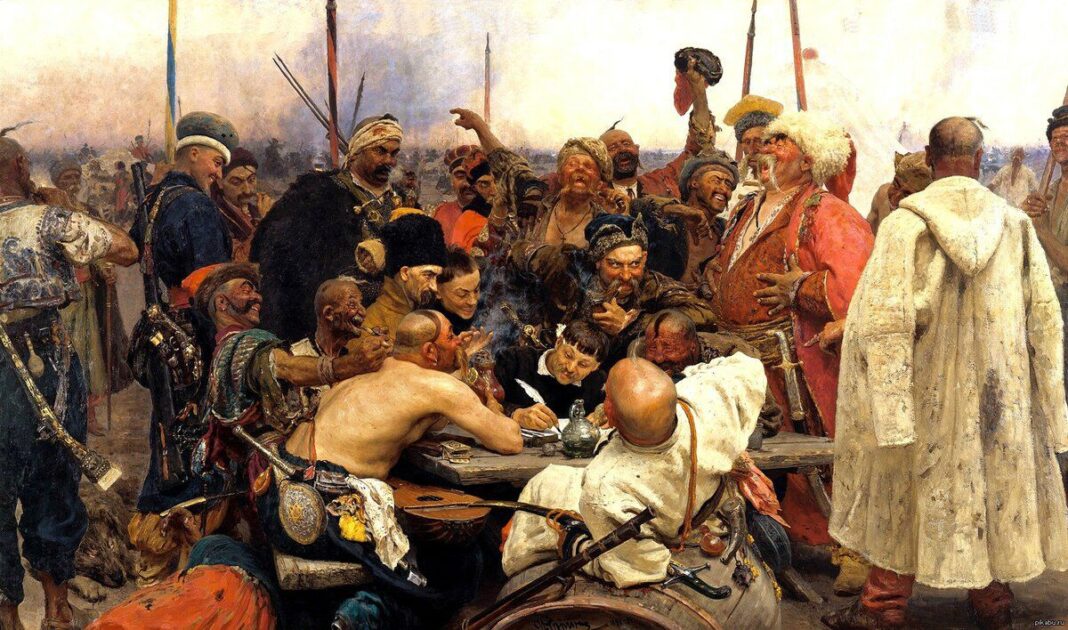The admirers of Russian culture remember this painting by Ilya Repin “The Cossacks”. Or, as it is popularly called, “Cossacks are writing a letter to the Turkish Sultan”.
But what did they really write? Judging by the expressions on their faces, they are clearly not writing an analytical and economic treatise. It became interesting to me and I decided to understand this story. To begin with, I will clarify that the letter itself has not been found – there are only copies of it. Therefore, whether the reply letter was itself or not is not conclusively proven. But that doesn’t matter. Even as a legend, this story conveys the atmosphere of those times and the spirit of the free Zaporozhye Cossacks.
So, history itself took place in the 17th century. Turkish Sultan Mehmed IV subdued the right-bank Ukraine and sent a letter to the Zaporozhye Sich. The requirement was simple – to obey the Sultan and become his vassals. Half of the Sultan’s letter was dedicated to his great statuses – the ruler of the world, the invincible warrior, the viceroy of God on Earth, etc.
Interestingly, the writing style hints at the fact that Mehmed wanted to have the Cossacks as his kind vassals. Usually he promised terrible punishment in case of insubordination. He tried not to provoke the Cossacks into aggression. But he provoked them into humor with his boasting.
Perhaps, if the Sultan wrote in a practical language, the Cossacks would have agreed with his demands. There was nothing wrong with becoming a vassal in the feudal era. You received patronage and military assistance from the most powerful empire at that time. Earlier, the hetman of right-bank Ukraine Petro Doroshenko took over the power of the Sultan.
But the Cossacks are freedom-loving by nature, and the excessive pathos of the Sultan simply made them laugh. And they wrote a response letter. This moment is captured in the famous picture.
What did the Cossacks write to the Turkish Sultan? Unfortunately, the original letter has not survived, there are only later versions of the letter text. There are several of them, but they are all written quite in the spirit of the Zaporozhye Cossacks.
Let us be guided by the text from the magazine “Russian Starina” for 1872, which is based on the documents of the historian Nikolai Kostomarov.
In a response letter, the Cossacks addressed the Sultan as “the Turkish Shaitan and the secretary of Lucifer himself.”
The Cossacks expressed doubt that the Sultan was an invincible knight. For, according to the Cossacks, the sultan could not have resisted an ordinary hedgehog with a naked sirloin.
Further, the Cossacks changed all the royal titles in their own way.
“You are a Babylonian cook, a Macedonian charioteer, a Jerusalem brewer, a swineherd of Great and Lesser Egypt, an Armenian thief.” Well, you get the structure. The authors simply took each region where the sultan ruled, and instead of the word “lord” they added one of the curses. “You are not fit to feed Christian pigs,” summarize the Zaporozhian people.
The letter was signed by Ataman Ivan Sirko. By the way, this is the legendary chieftain – he participated in the uprising of Bohdan Khmelnitsky, was an ardent defender of Orthodoxy. The Turks were very afraid of him and called him “Russian shaitan”.
What happened next? In 1672-1681 there was a Russian-Turkish war. On the side of the Ottoman Empire, the Crimean Khanate, vassal to him, also came out. Russia lost the war, but did not suffer a crushing defeat and managed to save the left-bank Ukraine.
Well, Ilya Repin approached the question like a real professional. He painted the picture for 10 years. For this he went to Zaporozhye, talked with people. Studied in detail the history and costumes of that era and found several typical types, which he wrote from nature.









